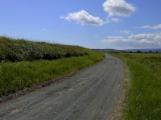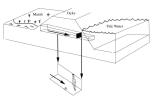5
Sometimes the dyke, especially if it was very exposed to erosion, would have brush or planks added to the tide sides of the dyke to give it added stability. This is often seen in Dutch dykes facing the North Sea.While the men from several family farms would work together to build the aboiteau and the dykes around it, it was the responsibility of each farm family to maintain its own area of reclaimed marshland. The men with marshland along a segment of river would get together when more dyking was requested, to listen to the reasoning of the complainant. If the man was convincing, or the problem obvious, it would be approved and the men went to work as a team. Once the dyke was built a track would be added on top and ramps up to it would be built so that farm carts could move along the track.
6
A group of men constructing an Aboiteau on the Shepody Marsh.19 September 1870
Shepody Marsh, New Brunswick, Canada
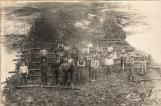
7
A group of men, oxen and horses constructing an Aboiteau.19 September 1870
Shepody Marsh, New Brunswick, Canada
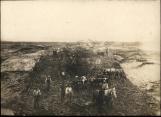
8
Tide water rushing over an Aboiteau which is under construction.19 September 1870
Shepody Marsh, New Brunswick, Canada
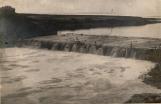
9
A group of men, oxen and horses constructing an Aboiteau using mud, logs and brush.19 September 1870
Shepody Marsh, New Brunswick, Canada
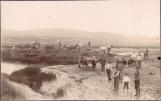
10
The remains of an original aboiteau from the nineteenth century.15 September 1870
Shepody Marsh, New Brunswick, Canada
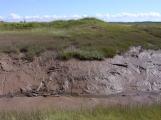
11
The aboiteau was a specially designed section of the dyke which would allow water from streams or rivers to flow out into the Bay but prevent tide water from flowing through the aboiteau and onto the marsh. The aboiteau was constructed with a square pipe up to five feet wide, made of thick planks, running from the stream on the marsh side of the dyke through the base of the aboiteau and out into the Bay. Inside the pipe is a gate which swings out to allow the stream water to escape, but is shut closed by the force of the tide water rushing into the pipe. The gate is blocked and therefore cannot swing inward.13
This design is still used today in some modern dykes.14
This photo shows the Bay side of a modern aboiteau.15 September 1940
Shepody Marsh, New Brunswick, Canada
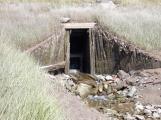
15
This photo shows the marsh side of a modern aboiteau.15 September 1940
Shepody Marsh, New Brunswick, Canada
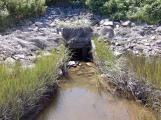
16
The dykes visitors see today are not those built by the Acadian families. They built their dykes much closer to the bottom of the hills and not so far out on the marsh. The reason is because they did not need a large amount of dyked marsh. They only grew small crops and had few animals, so building large dykes like those we see today would have been a waste of energy. As the communities grew new dykes would be built farther out on the marsh to reclaim more land.17
This photo shows what a modern dyke looks like.15 September 2003
Shepody Marsh, New Brunswick, Canada
